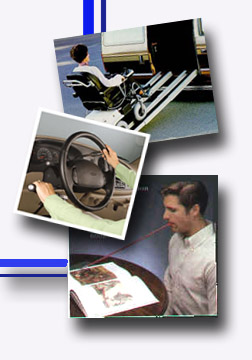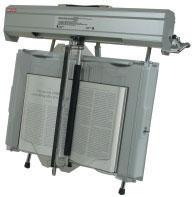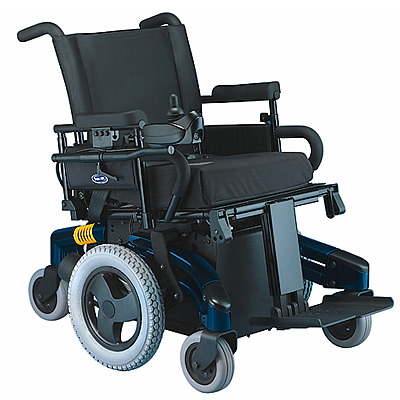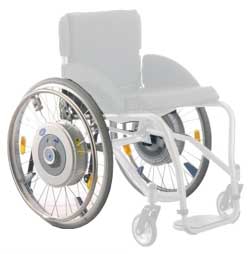Assistive Technology Applications For People With Mobility Impairments
Mobility impairments are often the result of orthopedic or neuromuscular disorders such as amputation, paralysis, spinal cord injury, Cerebral Palsy, Multiple Sclerosis, stroke, Traumatic Brain Injury (TBI), Muscular Dystrophy. Characteristics of mobility impairments include: muscular weakness, manipulative, positioning, and ambulatory difficulties, poor muscular strength, and in some cases pain. Mobility impairments describe a wide range of impairments from lower extremity impairments that may require someone to use a cane or walker to assist walking to upper extremity impairments which can limit the use of one's hands. Due to the wide variety of mobility disabilities and diagnoses, it is impossible to generalize the functional ability of someone with a mobility impairment. Also because of the wide range and levels of mobility impairments, the category of AT for people with mobility impairments encompasses many different types of devices. Numerous AT devices are available to help people with mobility impairments with transportation, activities of daily living (dressing, eating, brushing teeth, etc.), environmental control (control of lights, TV, radio, etc.), and computer access.
Low Tech/ No Tech Assistive Technology
Low tech devices are often a simple and cost effective solutions that utilize skills someone possesses to complete tasks that require skills that, due to their disability, the person does not possess. Canes and walkers are examples of low tech devices that are commonly used to assist people who's mobility impairment inhibits their ability to walk normally. A manual wheelchair, a low tech device because it lacks a power source, utilizes an individual's ability to use their hands and arms to propel themselves forward out of necessity when a mobility impairment prevents them from walking.
Low tech devices are often used to assist with activities of daily living and one of the most common devices is an enlarged grip. This is used to increase the diameter of the handle of several commonly used devices such as eating utensils, toothbrushes, combs, etc. that someone with a mobility impairment may have difficulty gripping. Other low tech devices that can be used for everything from helping turn a page in a book, to pressing a button on a remote control, to pressing keys on a computer are head pointers, mouth sticks, and typing aids. These devices consist of a small rubber point at the end of a rigid, plastic protrusion that is used by a part of the body (i.e. head, mouth, or hand) the user can control. They are used by people with various mobility impairments who have difficulty isolating a pointing motion with a finger to perform tasks the require a point, such as pressing small buttons. The examples listed here are not the only low tech AT devices for people with mobility impairments, they are simply some of the most commonly used devices. The definition of low tech devices is broad enough that any simple device one can use to assist with performing a task can be considered a low tech AT device.
Mid Tech
Most AT devices for people with mobility impairments fall under the categories of low tech or high tech, there are however a few types of devices that fit into the mid tech category. Examples of mid tech devices are automatic page turners and feeding devices. Automatic page turners turn a page of a book when the user activates a button. This provides people with upper extremity impairments independent access to books. Feeding devices contain a movable arm that pushes food off of a plate onto a fork or into the users mouth following a button activation. One other common device that fits in this category is the automatic door opener. These are found in many buildings to provide access to someone with a mobility impairment that has difficulty opening a door by simply pressing a button. Again, this is a sample of mid tech devices, not an all inclusive list.
High Tech
High tech AT devices typically fall into one of three sub-categories, transportation, environmental control, or computer access. There are many examples of assistive devices in each of these categories. The examples given in this section do not cover all of the devices available.
AT for transportation refers to the wheelchair and devices that someone with a disability uses to assist in vehicular transportation. Manual wheelchairs were considered low tech devices. Power wheelchairs and power assist wheelchairs (wheelchairs similar to manual wheelchairs that provide a battery powered boost when a wheel is pushed to allow use by people with minimal mobility in their upper extremities) are considered high tech AT. These wheelchairs are considered high tech based on their power and control systems, which manual wheelchairs do not possess. Wheelchair usage can cause difficulty getting in and out of vehicles for longer distance transportation. Buses and vans can be equipped with electronic wheelchair lifts to help wheelchair users get in and out of these modes of transportation successfully. If someone has only a lower extremity mobility impairment, he/she still has the ability to operate a vehicle with some specific modifications. Hand controls can be installed in a car that allow a user to control the gas and brake with one hand while steering with another. These high tech devices make independent transportation possible for people with lower extremity mobility impairments.
Some mobility impairments cause people to have difficulty controlling devices within their environment such as lights, televisions, radios, doors, and telephones. Devices are available to control each of these devices individually as are devices that allow someone to control each of these devices from one central unit. Anything allowing someone to control household devices is called an environmental control unit (ECU). ECUs are either stand alone devices that are controlled by scrolling through a menu using a switch to select control options or computer-based devices controlled through voice control. With the increased use of infrared technology, the controls of an ECU are more frequently being incorporated into a user's power wheelchair control module. This provides the user a limited level of mobility when controlling devices through an ECU because it does not require them to be near a central device, just within reach via infrared. ECUs give people with mobility impairments the same level of independence and control of many electronic devices as those without impairments.
Computers can be an important tool for working, gathering information, and communication. They can be imperative for someone who's mobility impairment makes working from home more conducive than working in an office. Many high tech devices are available to help people with upper extremity mobility impairments to access a computer. These devices were discussed at length in Module 4.
Although there are many high tech devices available for people with mobility impairments, many of them are costly and thus unavailable to people without a means to purchase them. Depending on the level and cause of the impairment, wheelchairs can be covered by Medicaid or Medicare. To obtain many of these other devices, one often has to find other means of payment including loans, grants, or other agencies.
 |
| Mouth pointers and driving controls are other examples of how AT can benefit the lives of persons with mobility impairments. |
 |
| Automatic page turners provide people with upper extremity impairments independent access to books. |
 |
| Power wheelchairs allow independent control to people with an inability to propel a manual wheelchair. ECUs can also be incorporated into a power wheelchair's control module allowing the user to control lights, TVs, and other household electronics independently. |
 |
| Power assist wheelchairs have motors in their wheels that provide an extra boost when propelled manually to help those lacking strength or who fatigue easily to use a manual wheelchair. |